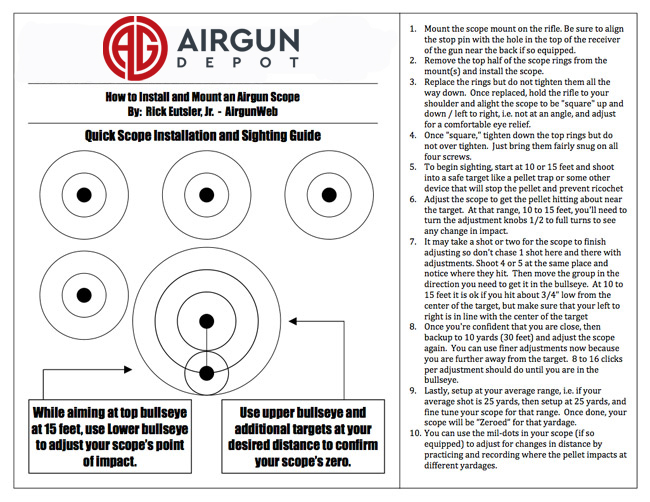Whether you’ve just purchased your first airgun with a bundled optic or you’re a seasoned pro, you’ll want to get your new scope mounted and sighted so you can get out and enjoy your airgun. Or, maybe you’re getting your gear set up for going out into the field for some hunting. Well, this guide should help you get on target quickly and easily. Let’s get started.
Prep the Area
Before throwing pellets in your magazine and twisting knobs on your scope, let’s prepare the shooting area. Right out of the gate, you’ll probably be shooting way off. You won’t know where your pellets will land and need to make allowance to capture errant shots. Ideally, shooting into a large dirt bank is very useful for making rough adjustments. Start at about 10 to 15 yards back, and make sure your scope is set to its lowest magnification. You’ll see the impact on the dirt and then be able to use the turrets to move the impact to the center. Remember that you turn the turrets in the direction that you want to move your POI (point of impact). So if you are way right of center, then you would turn the side turret “left” to move the shot to the left.
Helpful Post: What Do the Numbers Mean on a Rifle Scope
If you don’t have a safe backstop like a dirt pile, you will want to create something in your backyard or just find a safe, legal place to shoot so you can get on target. Remember, you always need to know your target and what’s beyond. Simple hay bales can work well, but note that if you are shooting something super accurate, you will create a hole right through the hay behind your bullseye, and your pellets will sail out the back of the bale. Be mindful of your environment.
In Your Backyard
Let’s assume that you are going to sight in your scope in your backyard and that you’ve got something set up to either stop or capture your pellets. A great way to be safe and get on target quickly is to use the Quick Scope Sight-In Target created by Rick Eutsler at Airgun Web.
Long story short, your barrel is not in-line with the sight line of your scope. It sits above the bore. So if you try to sight in 10 or 15 feet, you’ll be at a terrible angle for anything other than shooting at that distance. To account for this, the above target has two points. An aiming point and an impact point. The impact point is about 1.75” below the aim point, which is the typical height of the scope over the bore. By using this method (see the target for complete instructions), you will get on target quickly and be close enough, at say 20 or 30 yards, to make your final adjustments. You can also use something like the Champion Heavy Duty Pellet Trap or our Silent Pellet trap as a safe backstop.
Please note that we are dealing with pellets here and not BBs. If you are trying to sight in a scope on a BB gun, you need to use something that prevents ricochet. Our silent pellet trap would be ideal.
Dialing in Your Scope for Perfect Accuracy
A lot of what we are talking about today comes from years of experience. Here are some important tips to help you get right on target.
- Square up your reticle. If you are only ever going to shoot at one distance, this part is less of an issue. Some people can get “close enough” with their reticle to be square to the bore and not canted left or right. But, it’s more common for folks to have a natural cant to their hold, which in turn then translates to how they see the reticle. If the reticle is canted, then it’s not perfectly centered with the bore of your gun. This will cause your shots to wander left to right, depending on how far you are from your initial zero. We’ve seen people chase their POI all over the place simply because their reticle is not square. Real Avid puts out a tool that we’ve found that works well. The Level Right Pro (https://www.realavid.com/product/level-right-pro/) takes your hold out of the equation and allows you to make sure that you are squared up perfectly before you start the zeroing process.
- Move your average group to the center, not one shot at a time. It would be great if all our airguns were perfectly accurate all the time. Fact is, they aren’t. User error, ammo inconsistencies, and environmental conditions all lead to shots not hitting the same point twice. It’s best to take 3 to 5 shots and then move the group to center. This will help you get on target with less frustration.
- Adjust one direction at a time. Scopes have a tube in them that’s held in place by springs. When you turn the turret, you are increasing or decreasing the pressure against these springs, moving the tube. Some scopes need a little “help” to settle in after adjustment. The issue is worsened when you adjust in two directions as one. So, move your shot so that it’s in line with where it needs to be, and then move the other adjustment to bring it to the center of the bull.
- Lastly, don’t be afraid to reset and start over. Sometimes we can just get way ahead of ourselves and feel like there’s no way to recover accuracy. When this happens, center your scope tube and start over. Here’s how you do it. First, turn the left-right turret all the way till it stops. Now count how many “turns” it takes to get it all the way in the other direction. You can count clicks if you want, but just close enough is usually sufficient. Let’s say it’s 11 “turns.” Now take it back about 5 turns back the other direction. You get the idea. You want to split the difference. Repeat this process for the up-down turret and you are basically back to optical center. If you take a shot and are just WAY off, then you may have an issue with your mounts, receiver, or barrel, and no amount of sighting in is going to fix the problem. So what do you do?
- Adjustable mounts are your last option. There are scope mounts that allow for adjustment in all directions. These mounts help overcome things being way out of spec, but they can also improve accuracy by helping your scope be as close as possible to optical zero. How they work may need a completely new article, but they are available if you’ve exhausted all other options.
That’s a Wrap
We know that’s a lot of data to digest in one article, and we hope it was useful. However, if you find yourself in need of more guidance, please give us a call. We are always happy to help.

